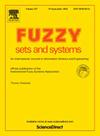从不断变化的数据流中进行增量学习和粒度计算:基于语音的躁郁症诊断应用
IF 3.2
1区 数学
Q2 COMPUTER SCIENCE, THEORY & METHODS
引用次数: 0
摘要
我们将一种名为 "进化最优粒度系统(eOGS)"的进化粒度计算建模方法应用于基于语音数据流的躁郁症(BD)诊断。eOGS 在线学习算法能揭示数据流中的信息颗粒,并根据医院精神科 7 个月来电话中的声音属性,设计出具有一定可解释性的颗粒规则模型的结构和参数。本文提出了一个多目标编程问题,在信息特异性、模型紧凑性以及数值和颗粒误差指数之间进行权衡。根据混合 Pearson-Spearman 相关系数对频谱和前音属性进行排序和选择。结果表明,属性-类别相关性较低,从 0.03 到 0.07 不等,而类别重叠率较高,这在精神病学领域是很典型的。用于 BD 识别的 eOGS 模型在最佳和平均情况下都以微弱优势战胜了其他计算智能模型,即动态演化神经-模糊推理系统(DENFIS)和基于模糊集的演化建模(FBeM-Gauss);其次是 eXtended Takagi-Sugeno 模型(xTS)和演化 Takagi Sugeno 模型(eTS)。拟议的 eOGS 模型仅使用了 8 个原始声学属性和约 15 条 "If-Then "推理规则,表现出最佳均方根误差(0.1361)和 91.8% 的尖锐 BD 类别估计准确率。与语言标签相关的粒度和粒度输入输出图为人类提供了与生成类别估计的固有过程相关的可理解性。语言可读的 eOGS 规则可帮助医生解释症状和做出诊断。本文章由计算机程序翻译,如有差异,请以英文原文为准。
Incremental learning and granular computing from evolving data streams: An application to speech-based bipolar disorder diagnosis
We apply an evolving granular-computing modeling approach, called evolving Optimal Granular System (eOGS), to bipolar mood disorder (BD) diagnosis based on speech data streams. The eOGS online learning algorithm reveals information granules in the flow and design the structure and parameters of a granular rule-based model with a certain degree of interpretability based on acoustic attributes obtained from phone calls made over 7 months to the Psychiatry department of a hospital. A multi-objective programming problem that trades-off information specificity, model compactness, and numerical and granular error indices is presented. Spectral and prosodic attributes are ranked and selected based on a hybrid Pearson-Spearman correlation coefficient. Low attribute-class correlation, ranging from 0.03 to 0.07, is observed, as well as high class overlap, which is typical in the psychiatric field. eOGS models for BD recognition overcome alternative computational-intelligence models, namely, Dynamic Evolving Neural-Fuzzy Inference System (DENFIS) and Fuzzy-set-Based evolving Modeling (FBeM-Gauss), by a small margin in both best and average cases; followed by eXtended Takagi-Sugeno (xTS) and evolving Takagi Sugeno (eTS) types of models. The proposed eOGS model using only 8 of the original acoustic attributes, and about 15 ‘If-Then’ inference rules, has exhibited the best root mean square error, 0.1361, and 91.8% accuracy in sharp BD class estimates. Granules associated to linguistic labels and a granular input-output map offer human understandability with relation to the inherent process of generating class estimates. Linguistically readable eOGS rules may assist physicians in explaining symptoms and making a diagnosis.
求助全文
通过发布文献求助,成功后即可免费获取论文全文。
去求助
来源期刊

Fuzzy Sets and Systems
数学-计算机:理论方法
CiteScore
6.50
自引率
17.90%
发文量
321
审稿时长
6.1 months
期刊介绍:
Since its launching in 1978, the journal Fuzzy Sets and Systems has been devoted to the international advancement of the theory and application of fuzzy sets and systems. The theory of fuzzy sets now encompasses a well organized corpus of basic notions including (and not restricted to) aggregation operations, a generalized theory of relations, specific measures of information content, a calculus of fuzzy numbers. Fuzzy sets are also the cornerstone of a non-additive uncertainty theory, namely possibility theory, and of a versatile tool for both linguistic and numerical modeling: fuzzy rule-based systems. Numerous works now combine fuzzy concepts with other scientific disciplines as well as modern technologies.
In mathematics fuzzy sets have triggered new research topics in connection with category theory, topology, algebra, analysis. Fuzzy sets are also part of a recent trend in the study of generalized measures and integrals, and are combined with statistical methods. Furthermore, fuzzy sets have strong logical underpinnings in the tradition of many-valued logics.
 求助内容:
求助内容: 应助结果提醒方式:
应助结果提醒方式:


